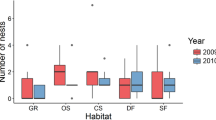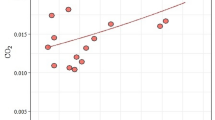Summary
Caterpillars of Maculinea arion are obligate predators of the brood of Myrmica sabuleti ants. In the aboratory, caterpillars eat the largest available ant larvae, although eggs, small larvae and prepupae are also palatable. This is an efficient way to predate. It ensures that newly-adopted caterpillars consume the final part of the first cohort of ant brood in a nest, before this pupates in early autumn and becomes unavailable as prey. At the same time, the fixed number of larvae in the second cohort is left to grow larger before being killed in late autumn and spring. Caterpillars also improve their feeding efficiency by hibernating for longer than ants in spring, losing just 6% of their weight while the biomass of ant larvae increases by 27%. Final instar caterpillars acquire more than 99% of their ultimate biomass in Myrmica nests, growing from 1.3 mg to an estimated 173 mg. A close correlation was found between the weights of caterpillars throughout autumn and the number of large ant larvae they had eaten. This was used to calculate the number of larvae eaten in spring, allowing both for the loss of caterpillar weight during winter and the increase in the size of their prey in spring. It is estimated that 230 of the largest available larvae, and a minimum nest size of 354 M. sabuleti workers, is needed to support one butterfly. Few wild M. sabuleti nests are this large: on one site, it was estimated that 85% of nests were too small to produce a butterfly, and only 5% could support two or more. This prediction was confirmed by the mortalities of 376 caterpillars in 151 wild M. sabuleti nests there. Mortalities were particularly high in nests that adopted more than two caterpillars, apparently due to scramble competition and starvation in autumn. Survival was higher than predicted in wild nests that adopted one caterpillar. These caterpillars seldom exhaust their food before spring, when there is intense competition among Myrmica for nest sites. Ants often desert their nests in the absence of brood, leaving the caterpillar behind. Vacant nests are frequently repopulated by a neighbouring colony, carrying in a fresh supply of brood. Maculinea arion caterpillars have an exceptional ability to withstand starvation, and sometimes survive to parasitize more than one Myrmica colony. Despite these adaptations, predation is an inefficient way to exploit the resources of a Myrmica nest. By contrast, Maculinea rebeli feeds mainly at a lower trophic level, on the regurgitations of worker ants. Published data show that Myrmica nests can support 6 times more caterpillars of Maculinea rebeli than of M. arion in the laboratory. This is confirmed by field data.
Similar content being viewed by others
References
Brian MV (1950) The stable winter population structure in species of Myrmica. J Anim Ecol 19: 119–123
Brian MV (1951) Summer population changes in colonies of the ant Myrmica. Physiol Comp Oecol 2: 255–257
Brian MV (1973) Feeding and growth in the ant Myrmica. J Anim Ecol 42: 37–53
Brian MV, Carr CAH (1960) The influence of the queen on brood rearing in ants of the genus Myrmica. J Insect Physiol 5: 81–94
Brian MV, Clarke RT, Jones RM (1981) A numerical model of an ant society. J Anim Ecol 50: 387–406
Chapman TA (1916) Observations completing an outline of the life-history of Lycaena arion L. Trans Entomol Soc London 1915: 298–312
Chapman TA (1918) On the life history of Lycaena alcon F. Etud Lepid Comp 16: 277–300
Clarke CA (1954) Breeding the large blue butterfly in captivity 1953–54. Entomol Rec 60: 209–210
Cottrell CB (1984) Aphytophagy in butterflies: its relationship to myrmecophily. J Linn Soc (Zool) 79: 1–57
Elfferich NW (1963) Kweekervaringen met Maculinea alcon. Schiff. Entomol Ber 23: 46–52
Elmes GW (1974) The effect of colony population on caste size in three species of Myrmica (Hymenoptera, Formicidae). Insectes Soc 21: 213–230
Elmes GW, Wardlaw JC (1981) The quantity and quality of overwintered larvae in five species of Myrmica (Hymenoptera: Formicidae). J Zool London 193: 429–446
Elmes GW, Wardlaw JC (1982) Variations in populations of Myrmica sabuleti and M. scabrinodis (Formicidae: Hymenoptera) living in Southern England, Pedobiologia 23: 90–97
Elmes GW, Thomas JA (1987) Die Gattung Maculinea. In: Geiger W (ed) Tagfalter und ihr Lebensraum. Schweizerisches Bund für Naturschutz, Basel, pp 354–368
Elmes GW, Thomas JA, Wardlaw JC (1991a) Larvae of Maculinea rebeli, a large-blue butterfly, and their Myrmica host ants: wild adoption and behaviour in ant nests. J Zool London 223: 447–460
Elmes GW, Wardlaw JC, Thomas JA (1991b) Larvae of Maculinea rebeli, a large-blue butterfly, and their Myrmica host ants: patterns of caterpillar growth and survival. J Zool London 224: 79–92
Frohawk FW (1906) Completion of the life history of Lycaena arion. The Entomologist 39: 145–147
Frohawk FW (1924) Natural history of British butterflies. Hutchinson London
Hassell MP (1975) Density-dependence in single-species populations. J Anim Ecol 44: 283–295
Hassell MP (1976) The dynamics of competition and predation. Edward Arnold, London
Hochberg M, Thomas JA, Elmes GW (1992) The population dynamics of a large blue butterfly, Maculinea rebeli, a parasite of red ant nests. J Anim Ecol 61: (in press)
Lawton JH (1970) Feeding and food energy assimilation in larvae of the damselfly Pyrrhosoma nymphula (Sulz.) (Odonata: Zygoptera). J Anim Ecol 39: 669–689
Malicky H (1969) Versuch einer Analyse der ökologischen Beziehungen zwischen Lycaeniden (Lepidoptera) und Formiciden (Hymenoptera). Tijdschr Entomol 112: 213–298
Purefoy EB (1953) An unpublished account of experiments carried out at East Farleigh, Kent, in 1915 and subsequent years on the life history of Maculinea arion, the large blue butterfly. Proc R Entomol Soc London (A) 28: 160–162
Thomas JA (1977) Second report on the conservation of the large blue butterfly. Institute of Terrestrial Ecology, UK
Thomas JA (1984) The conservation of butterflies in temperate climates: past efforts and lessons for the future. Symp Royal Entomol Soc London 11: 333–353
Thomas (in press) Relationships between butterflies and ants. In: Dennis RLH (ed) The ecology of British butterflies. Oxford University Press, Oxford, Chapter 7
Thomas JA, Wardlaw JC (1990) The effect of queen ants on the survival of Maculinea arion larvae in Myrmica ant nests. Oecologia 85: 87–91
Thomas JA, Elmes GW, Wardlaw JC, Woyciechowski M (1989) Host specificity among Maculinea butterflies in Myrmica ant nests. Oecologia 79: 452–457
Thomas JA, Munguira MC, Martin J, Elmes GW (1991) Basal hatching in Maculinea butterfly eggs: a consequence of advanced myrmecophily? Biol J Linn Soc 44: 175–184
Author information
Authors and Affiliations
Rights and permissions
About this article
Cite this article
Thomas, J.A., Wardlaw, J.C. The capacity of a Myrmica ant nest to support a predacious species of Maculinea butterfly. Oecologia 91, 101–109 (1992). https://doi.org/10.1007/BF00317247
Received:
Accepted:
Issue Date:
DOI: https://doi.org/10.1007/BF00317247




